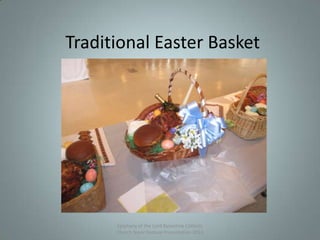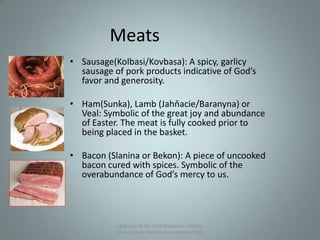Traditional easter basket
- 1. Traditional Easter Basket Epiphany of the Lord Byzantine Catholic Church Slavic Festival Presentation 2013 1
- 2. Background of the Traditional Easter Basket âĒ Pre-Christianity: Spring was eagerly awaited, greeted and celebrated when it arrived. Various rituals were performed because Spring in an agrarian society was the most important season of the year. Rituals included: songs, group dances, the baking of special breads, burning of fires, coloring eggs, decorating pysanky and dousing with water. âĒ With the introduction of Christianity to Ukraine( 988 A.D.) and other regions, the Church adopted many of these annual rituals into the Christian holidays. Epiphany of the Lord Byzantine Catholic Church Slavic Festival Presentation 2013 2
- 3. Background of the Traditional Easter Basket (continued) âĒ The lively, beautiful and colorful traditions, whether religious or cultural, have been passed down from generation to generation. âĒ Together, young and old experience these joyous times, sharing that which once celebrated by their forefathers. One of these cherished experiences is the Traditional Blessing of the Easter Basket. Epiphany of the Lord Byzantine Catholic Church Slavic Festival Presentation 2013 3
- 4. Background of the Traditional Easter Basket (continued) âĒ The Easter Basket of special foods is arranged usually on Easter Sunday and taken to church. A special blessing ceremony with prayers and sprinkling with Holy Water is performed usually by the parish priest after the Liturgy. âĒ In years past, what went into a food basket depended on the region one is from, the family's preferences and even financial means. âĒ A special blessing ceremony with prayers and sprinkling with Holy Water is performed usually by the parish priest after the Liturgy. Epiphany of the Lord Byzantine Catholic Church Slavic Festival Presentation 2013 4
- 5. Background of the Traditional Easter Basket (continued) âĒ This blessed food prepared days before and packaged usually on Easter morning is not be consumed until after the Resurrection Liturgy on Easter Sunday. âĒ The food in the basket should be the only food being consumed at the family Easter Brunch, which breaks The Great Lent fasting. Epiphany of the Lord Byzantine Catholic Church Slavic Festival Presentation 2013 5
- 6. The Traditional Easter Basket Presentation This presentation shares what most Slovaks, Ukrainians and Russians put in their baskets. Many recipes are cross-cultural since Slovak, Ukrainian, Carpatho-Rusyn and Russian cuisine has been influenced by neighboring Poland, Austria, the Czech Republic, and Hungary. Epiphany of the Lord Byzantine Catholic Church Slavic Festival Presentation 2013 6
- 7. Whatâs Included in the Traditional Easter Basket Epiphany of the Lord Byzantine Catholic Church Slavic Festival Presentation 2013 7 Contents of Basket
- 8. First, the Basket. âĒ The straw or wicker basket does not have to be elaborate. You will be filling it with traditional food. Epiphany of the Lord Byzantine Catholic Church Slavic Festival Presentation 2013 8
- 9. Next, the Food Contents of the Traditional Easter Basket âĒ Pascha or Paska âĒ Butter âĒ Meat: Ham, Bacon, Lamb or Veal âĒ Sausage or kolbasi âĒ Horseradish mixed with beets âĒ Salt âĒ Colored Hardboiled Eggs âĒ Egg Cheese, Siretz or Hrudka Epiphany of the Lord Byzantine Catholic Church Slavic Festival Presentation 2013 9
- 10. Pascha or Paska âĒ The Easter Bread, Pascha or paska is a sweet, round loaf of yeast bread made of white flour, eggs, milk, raisins based with a golden crust decorated with a symbol indicative of Christ. Sometimes a cross of dough is placed on top encircled by a plait giving it a crowned effect. It is symbolic of our Christ himself who is our true bread. âĒ The antiquity of the paska as a ritual bread is evidenced by the decorations which adorned the bread. In ancient times, the top of the paska was covered with symbolic signs made of dough such as a cross, solar signs, rosettes, leaves, pine cones even birds and bees. The majority of these decorations were remnants of an ancient pagan religion tied to the cult of the sun and bread. Epiphany of the Lord Byzantine Catholic Church Slavic Festival Presentation 2013 10
- 11. Colored Hardboiled Eggs âĒ Eggs symbolize the emergence of new life. The eggs are colored because of a tradition that says that Mary, the Mother of Jesus wanted to take something to Pilate so he would not let Jesus be crucified but all she had were some eggs. When Mary wept when she saw Jesus was condemned, her tears dyed to eggs into many different colors. The eggs are a sign of joy, reminding Mary that her Son lives forever. âĒ Many eggs are brightly colored and decorated with symbols and markings made with beeswax. These eggs are called pysanky Epiphany of the Lord Byzantine Catholic Church Slavic Festival Presentation 2013 11
- 12. Butter or Maslo âĒ This favorite dairy product is shaped into a figure of a lamb or small cross. The butter represents the Lamb of God who was offered on the altar of the Cross for the life of the world. âĒ The butter reminds us of the goodness of Christ that we should have toward all things. Epiphany of the Lord Byzantine Catholic Church Slavic Festival Presentation 2013 12
- 13. Horseradish(Chrin or Khrin) âĒ Horseradish mixed with grated red beets is symbolic of the Passion of Christ still in our minds but sweetened with some sugar because of the Resurrection. A bitter-sweet red colored mixture reminds us of the sufferings of Christ. Epiphany of the Lord Byzantine Catholic Church Slavic Festival Presentation 2013 13
- 14. Meats âĒ Sausage(Kolbasi/Kovbasa): A spicy, garlicy sausage of pork products indicative of Godâs favor and generosity. âĒ Ham(Sunka), Lamb (JahÅacie/Baranyna) or Veal: Symbolic of the great joy and abundance of Easter. The meat is fully cooked prior to being placed in the basket. âĒ Bacon (Slanina or Bekon): A piece of uncooked bacon cured with spices. Symbolic of the overabundance of Godâs mercy to us. Epiphany of the Lord Byzantine Catholic Church Slavic Festival Presentation 2013 14
- 15. Meats (continued) âĒ The meat products in the basket symbolize the sacrificial animals of the Old Testament; the true sacrifice of our Savior, who became for us â a Lamb of God, taking away the sins of the worldâ. âĒ Meat products also symbolize the fatten calf. The calf was prepared for the Prodigal Son (representing fallen mankind) on his return to his Heavenly Father. âĒ At Easter, we celebrate the return to God and our joyous participation in the blessings of our Savior. Epiphany of the Lord Byzantine Catholic Church Slavic Festival Presentation 2013 15
- 16. Salt or Sol âĒ Salt is a condiment necessary for flavor reminding the Christian of his duty to others. âĒ Salt symbolizes the Truth of the message of Christ. The teachings of Christ preserves our eternal life. Epiphany of the Lord Byzantine Catholic Church Slavic Festival Presentation 2013 16
- 17. Cheese (Hrudka or Sirets) âĒ This is a custard-type cheese shaped into a ball having a rather bland but sweet taste indicative of the moderation that Christians should have in all things. âĒ This cheese and all the dairy products remind us of the peace and prosperity of the Messianic age. Metaphorically, the milk and honey in the Bible signify wealth, especially spiritual. âĒ Also, creamed cheese is placed in a small dish and both are decorated with symbols our of cloves or pepper balls. Epiphany of the Lord Byzantine Catholic Church Slavic Festival Presentation 2013 17
- 18. Also in and on the Traditional Easter Basket Epiphany of the Lord Byzantine Catholic Church Slavic Festival Presentation 2013 âĒ Besides the special foods, the Easter Basket is also decorated with greenery and flowers. âĒ If the origin of the family is from a wine growing area, a sweet wine may be also included in the basket. âĒ Each wicker basket is covered with a linen cover usually embroidered with a picture of the Risen Christ or symbol with the words âChrist is Risen.â Many covers also include a Easter motif of pussy willows and pysanky âĒ Each basket should have a blessed candle in it to be lighted at the Blessing. âĒ Note that in some places a large Easter Bread is made and brought separately in a large linen cloth. 18
- 19. Enjoy Your Easter Basket âĒ Preparing the traditional Easter Basket is a spiritually pleasure that family and friends enjoy. âĒ And how sweet it isâĶ nothing tastes better than the food in your basket fasted from these foods during the Great Fast, especially Holy Week. Epiphany of the Lord Byzantine Catholic Church Slavic Festival Presentation 2013 19
- 20. Epiphany of the Lord Byzantine Catholic Church Slavic Festival Presentation 2013 20 Christ Is Risen! Indeed He is Risen!
- 21. âĒ SOURCES for the Information Contained in this Presentation. The majority of the information in this presentation is courtesy of Eastern Catholic Life and Epiphany of the Lord. â Kraynyak, Basil. âHow to Put Together a Traditional Easter Basket.â Eastern Catholic Life, Sunday, April 15, 2001, p.9. â âHow to Prepare An Easter Basket,â Epiphany of the Lord, 2013. â âUkrainian Easterâ, UkeMonde, http://www.ukemonde.com/easter/index.html, March 10, 2012. â Ukrainian Traditions, BRAMA- Gateway Ukraine, http://www.brama.com/art/easter.html, 2013. â Rolek, Barbara. âTraditional Slovak-Ukrainian-Russian Easter Basket for Blessing, Slovak- Ukrainian-Russian Easter Breakfast.â About.com Guide, http://easteuropeanfood.about.com/od/slovakeastertraditions/tp/Traditional-Slovak-Ukrainian- Rusyn-Easter-Basket-For-Blessing.htm. âĒ PHOTOS â Epiphany Photos (šÝšÝßĢ 6, 8, 10,11, 18 and 19) by Frank Kotula. Epiphany of the Lord Byzantine Catholic Church website, http://epiphanyofourlord.org/photosvideo.html. â Easter Basket (šÝšÝßĢ 7) Eastern Catholic Life Traditional Easter Basket, Sunday, April 15, 2001, p.9. â Food Products (šÝšÝßĢ 12 and 14), Rolek, Barbara. âTraditional Slovak-Ukrainian-Russian Easter Basket for Blessing, Slovak-Ukrainian-Russian Easter Breakfast.â About.com Guide, http://easteuropeanfood.about.com/od/slovakeastertraditions/tp/Traditional-Slovak-Ukrainian-Rusyn-Easter- Basket-For-Blessing.htm. â Linen Cloth (šÝšÝßĢ 20) image from yevshan.com largest online Ukrainian store. â Sirets Photo from allrecipes.com, (šÝšÝßĢ 17), http://allrecipes.com/recipe/sirecz-easter-cheese/detail.aspx â Kolbasi picture (šÝšÝßĢ from 14) http://meatclub.in/projects/kielbasa. â Horseradish (šÝšÝßĢ 13 ) from food.com. â Personal Photos (šÝšÝßĢ 1, 2, 4, 5 and 18) taken by Terry Matlaga Bell. Epiphany of the Lord Byzantine Catholic Church Slavic Festival Presentation 2013 21 ENDNOTES





















